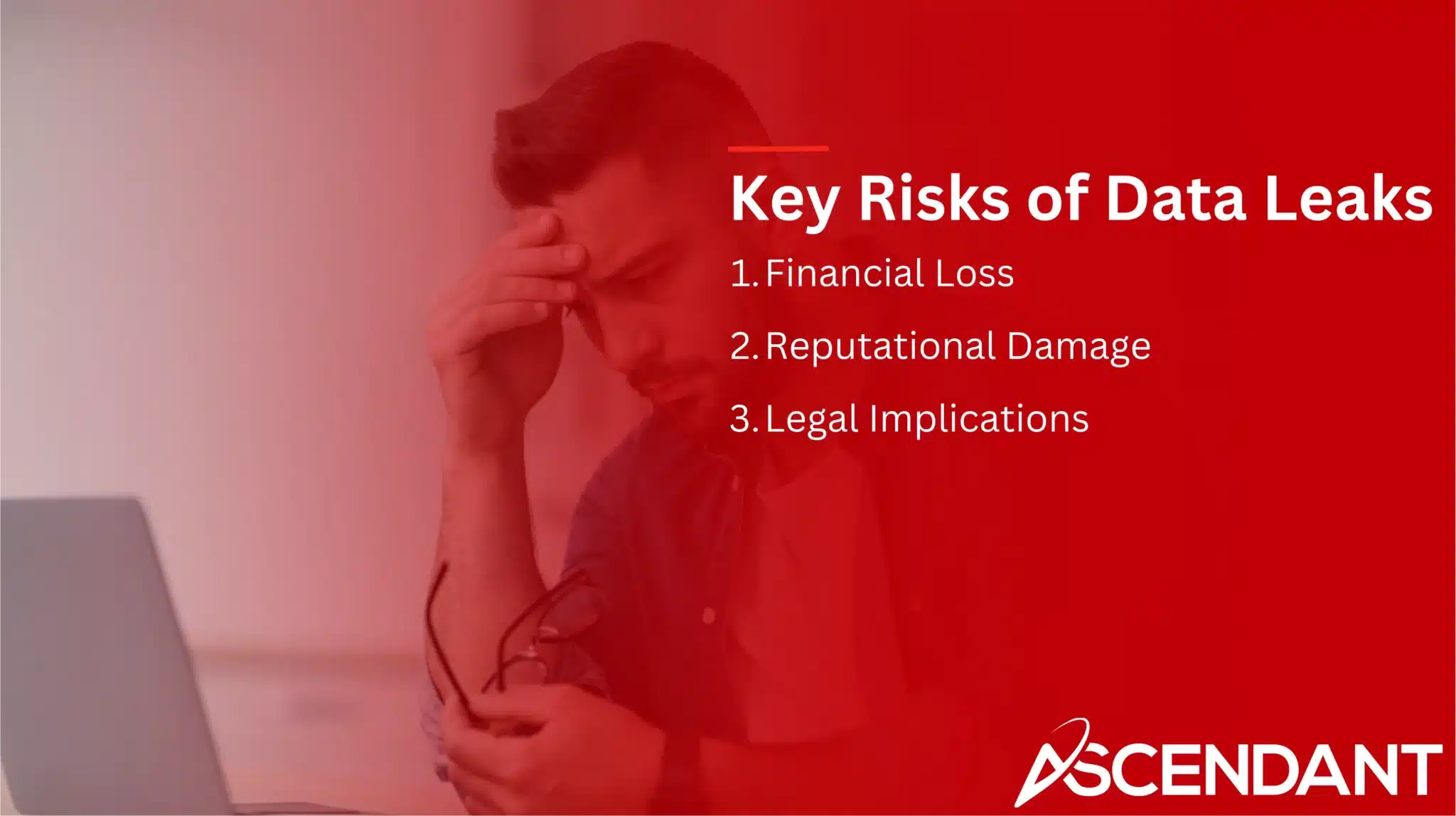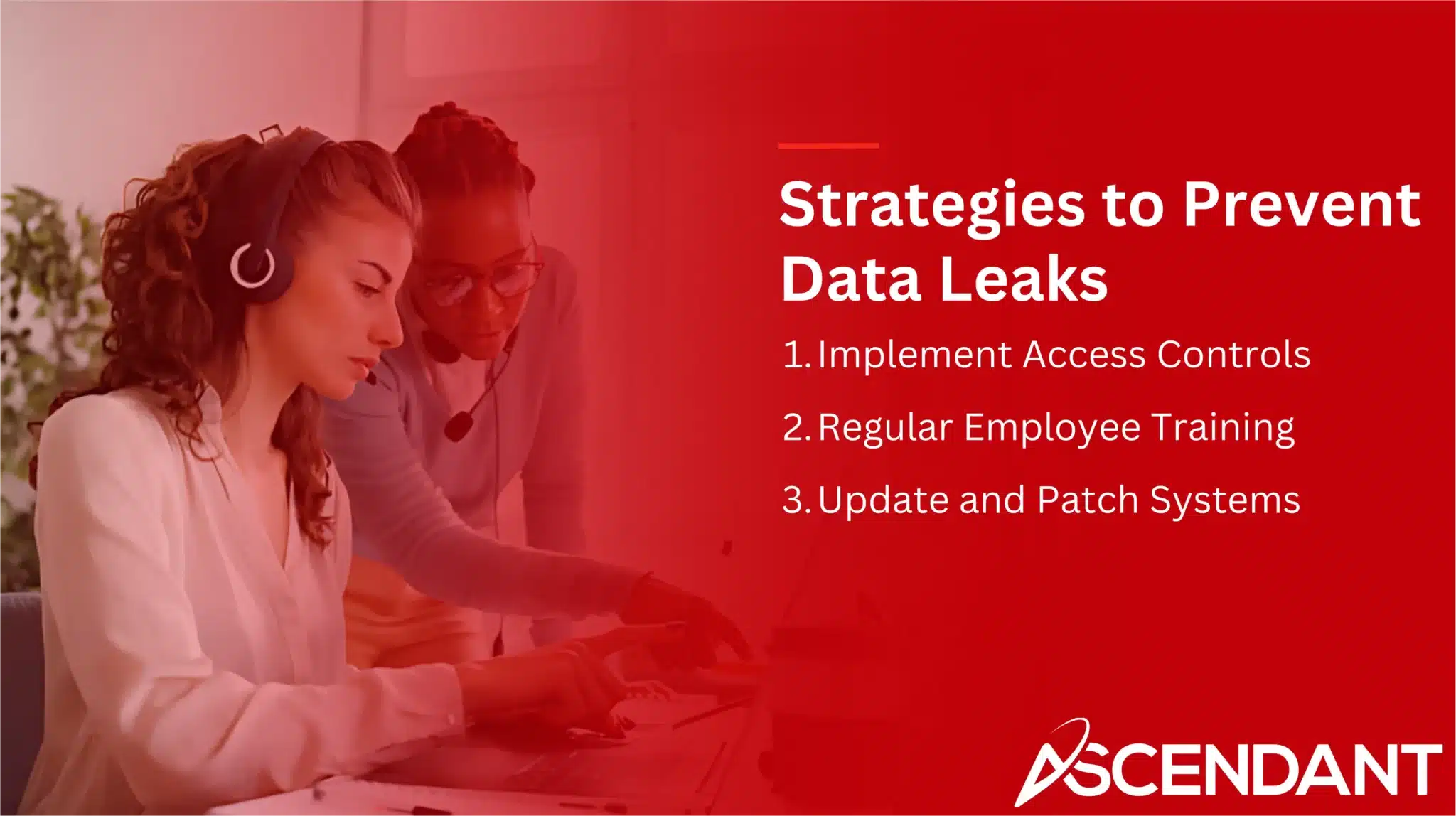Wondering what a data leak is and how to prevent it? A data leak happens when sensitive information is unintentionally exposed, often due to human error or technical flaws. This article breaks down the key risks, causes, and strategies to safeguard your data.
Key Takeaways
- Data leaks result from unintentional exposures of sensitive information due to human error or technical misconfigurations, necessitating comprehensive employee training and strict data handling protocols.
- The risks associated with data leaks include significant financial losses, reputational damage, and severe legal implications, underscoring the need for effective prevention strategies.
- Preventative measures, such as implementing access controls, regular employee training, and utilizing advanced technologies like DLP tools and MFA, are critical to safeguarding sensitive data from leaks.
Understanding Data Leaks
When sensitive data is inadvertently exposed outside of its designated secure environment, a data leak occurs. This exposure often stems from human mistakes or technical oversights rather than the malicious intent characterizing data breaches. Data leaks underscore weaknesses within an organization’s approach to safeguarding their information and may arise through several pathways such as employee mishandling of data or system configuration errors, thereby simplifying access for those not authorized to view sensitive information.
One common root cause of accidental dissemination of confidential details lies in employees accidentally passing on sensitive materials to unauthorized entities. The merging of personal devices into professional duties compounds this risk due to the lackluster security features typically present compared with enterprise-standard solutions—thus muddying the waters between private and work-related datasets and enhancing susceptibility to inadvertent leakage.
The persistence of human error as a leading factor in instances where protected information becomes accessible underlines the essential role that thorough training programs play in preventing these scenarios. By instilling strong cybersecurity awareness across personnel levels and implementing stringent guidelines for handling critical data, organizations can markedly diminish occurrences where proprietary knowledge might be unintentionally compromised.
Key Risks of Data Leaks
Data breaches expose organizations to a myriad of serious threats, not least among them being the dire financial repercussions. These can include direct theft of assets, exorbitant fines levied for non-compliance, and significant outlays involved in remediation efforts. Frequently instigated by cybercriminals with motives rooted in monetary gain, such attacks exploit weaknesses within software systems to infiltrate and extract sensitive information. It is worth noting that about 95% of security incidents occur due to human mistakes, which highlights the critical role that stringent data protection protocols play.
The consequences on an organization’s public image can be equally as catastrophic as financial detriments when it comes to data leaks. A poignant example lies with Capital One whose stock market valuation plummeted by 6% following a breach incident. This serves to highlight how quickly trust and customer loyalty can erode amidst revelations of compromised data integrity.
Lastly, there are severe legal ramifications associated with failing to safeguard sensitive information appropriately—with potential lawsuits and harsh regulatory sanctions awaiting those companies deemed negligent. Understanding these risks is paramount for devising prevention tactics aimed at robustly securing access points against unauthorized intrusions into sensitive datasets—each facet needs meticulous attention like fiscal losses demand thorough evaluation.
Financial Loss
A data leak can lead to immediate and grave financial consequences. For instance, a prominent technology manufacturer in the US experienced a profound financial loss amounting to $1.2 billion following a data breach. Not only do such breaches trigger direct monetary losses, but they also necessitate hefty expenditures for remedying the aftermath of these incidents, as evidenced by companies like T-Mobile, which have incurred considerable costs from managing the repercussions of data leaks.
The ramifications extend beyond just short-term fiscal damage. An organization’s operations may be severely interrupted by a data leak, thereby leading to enduring economic repercussions. The accumulated expenses involved with recovery efforts, legal charges, and potential penalties can heavily deplete an organization’s finances. This highlights the critical importance for entities to allocate resources towards comprehensive data security strategies in order to fend off such events.
Reputational Damage
Another significant hazard linked to data leaks is the threat of reputational harm. In the wake of a data breach, around one in three customers may decide to cease business with an impacted company across various sectors, leading to a severe drop in sales. The tarnishing image and diminished confidence from consumers can inflict lasting damage on an organization’s reputation, making trust recovery a formidable task.
To curb reputational damages, it’s crucial for organizations to communicate swiftly and openly with all stakeholders about what has transpired—the nature of the incident, its ramifications—alongside measures being taken for resolution. Establishing round-the-clock availability for stakeholder inquiries during such incidents and keeping an eye on social media platforms aids in controlling public perception and efficiently addressing concerns that arise.
Legal Implications
The repercussions of data leaks in a legal context can be considerable, potentially leading to court cases and fines imposed by regulatory bodies. Frequently, companies that fall victim to data breaches find themselves embroiled in litigation. Even with these legal proceedings, not all victims are compensated. There is a mandatory obligation for businesses to put into place sufficient safeguards for personal information protection, and non-compliance can attract serious legal penalties.
Illustrating the grave consequences following incidents of compromised data was the situation involving Equifax when four members from China’s military were indicted by American authorities due to their involvement in executing the cyberattack. These events emphasize how critical it is for organizations to adhere strictly to regulations concerning data security and demonstrate what could occur legally if they fail at safeguarding sensitive details.
Common Causes of Data Leaks
It is essential to pinpoint the predominant reasons behind data leaks in order to craft effective safeguards against them. Weak password practices stand out as a major culprit, leading to roughly 30% of individuals being compromised by data breaches. Carelessness among staff members who fail at adequately securing sensitive information also plays a role in these incidents. Vulnerabilities can emerge when employees depart from an organization and leave files filled with sensitive data unsecured.
Major factors contributing to both deliberate attacks and accidental security breaches include employee mistakes and gaps within the infrastructure’s protection mechanisms. The risk posed by using personal devices for professional tasks without proper firewall protections cannot be underestimated concerning safeguarding sensitive data. Recognizing these triggers is crucial in devising strong defensive strategies for maintaining robust data security measures.
Weak Passwords
Weak passwords stand as a frequent entry point for data breaches. To bolster data security and lessen the threat posed by such vulnerabilities, it’s crucial to deploy password management systems. These tools aid employees in generating robust, distinct passwords across various accounts, thereby markedly diminishing the likelihood of unsanctioned access.
Suffering from a data breach attributed to weak passwords can have dire outcomes: significant financial loss, tarnishing of reputation, and potential legal repercussions. Encouraging strong password practices along with the utilization of password managers allows organizations to safeguard sensitive data effectively against leaks.
Insider Threats
Organizations face substantial danger from insider threats, which occur when employees intentionally leak sensitive data. Employees harboring grievances or with malicious motives might exploit their positions to access confidential information like financial records and client details without authorization. The result of such deliberate acts can be the leakage of critical information, leading to catastrophic outcomes for the business.
In order to counteract these risks posed by insiders, it’s essential for organizations to reinforce their access control systems so that only individuals who are permitted can access sensitive data. Establishing strong surveillance and regulatory procedures is crucial in detecting and preventing potential insider threats before they escalate into serious breaches involving vital data.
Technical Misconfigurations
Improper settings in technical configurations can result in the exposure of sensitive data to parties without authorization. Leaks involving corporate data, which could include details like customer databases and unique research findings, represent a severe threat to organizations. The Equifax incident serves as an example. Attackers capitalized on an unpatched vulnerability in Apache Struts to gain entry into their network, culminating in a substantial data breach.
Organizations stand at risk of hefty regulatory penalties if they fail to adhere to laws governing data protection such as GDPR—a fine that might equal up to 4% of worldwide turnover. Regular updates and proper configuration management of systems are vital measures for preventing technical misconfigurations and securing access control over sensitive information.
Types of Sensitive Data at Risk
Protecting sensitive data is of utmost importance as it encompasses both personal information and corporate data, the exposure of which can result in significant consequences. Compromised personal information may comprise health records, financial details, and social security numbers – a breach that could lead to severe invasions of privacy. In contrast, corporate data might contain confidential trade secrets or proprietary knowledge whose disclosure could give rise to competitive setbacks.
Grasping the various categories of sensitive data under threat is key to devising robust measures for securing this data. A thorough investigation into the unique risks associated with personal information and corporate material is essential in reinforcing their safety against potential breaches.
Personal Information
Sensitive data including banking credentials, medical records, and social security numbers are extremely vulnerable to misuse. Should this information fall into the wrong hands due to a data breach, individuals may face profound repercussions. The exploitation of such personal details by cybercriminals can lead to identity theft where unauthorized parties might gain entry to social platforms, damage credit standings or engage in illicit buying activities.
In light of a data leak scenario, it’s imperative for entities responsible for safeguarding this information to offer substantial aid to those affected. This involves providing services like monitoring for signs of identity theft and ensuring transparent communication throughout the incident. Providing these measures not only sustains trust, but also helps alleviate potential long-term ramifications resulting from the compromised data security.
Corporate Data
Corporate data, including trade secrets and proprietary information, is also at significant risk during a data breach. If sensitive corporate data is publicly accessible, competitors can gain insights into company plans and revenue targets, leading to competitive disadvantages. Ensuring the protection of corporate data is essential for maintaining a company’s market position and strategic advantage.
Implementing strong data security measures helps protect data both personal and corporate data from unauthorized access, thereby preventing data leaks.
How Cybercriminals Exploit Leaked Data
Cybercriminals frequently target and obtain access to sensitive data by launching cyberattacks with the intention of monetary profit. Leaks of sensitive information, which can include proprietary trade secrets, confidential source code, and user credentials, provide a treasure trove for these malicious actors. They harness this accessed data in numerous nefarious acts aimed at both financial enrichment and committing identity theft.
Understanding the methods used by these adversaries to manipulate compromised data is crucial for devising robust strategies that prevent such incidents or mitigate their impact. These malevolent activities center around exploiting personal identities and acquiring illicit financial rewards through unauthorized access to private information.
Financial Gain
Cybercriminals frequently sell stolen data on the dark web to generate income. Personal details can fetch up to $62 each, making the dark web a lucrative marketplace for cybercriminals. This financial incentive drives cybercriminals to continuously seek vulnerabilities and opportunities to exploit leaked data.
By understanding the financial motivations behind cyberattacks, organizations can better protect their sensitive data and prevent data leaks.
Identity Theft
Identity theft can lead to significant emotional and psychological consequences for victims. Cybercriminals misuse stolen personal data to access social accounts, ruin a victim’s credit rating, spend on their cards, or create new identities. They can also manipulate stolen data to open new accounts or make unauthorized purchases in the victim’s name.
Understanding the severe impact of identity theft underscores the importance of protecting personal information and implementing robust data security measures.
Strategies to Prevent Data Leaks
To avert the occurrence of data leaks, it’s critical to adopt a comprehensive strategy that involves the establishment of access controls, consistent training for employees on data security practices, along with regular updates and patches applied to systems. Vigilance against unusual activities—such as external document sharing or downloading confidential information—is key in identifying possible threats from within an organization. It’s imperative to recognize that the robustness of cybersecurity measures is heavily dependent on the adherence to protocols by each individual employee.
Reflecting on preventing data leaks highlights how vital it is to prioritize implementing robust access controls.
Implement Access Controls
To diminish the possibility of data leaks, it is crucial to enact rigorous access controls that restrict who has the ability to reach sensitive data. When access controls are insufficient, there’s a heightened danger of sensitive information being exposed due to unnecessary or excessive permissions granted. To bolster data security, organizations must put in place measures such as user authentication procedures, role-based access schemes and persistent surveillance tactics.
Strengthening these protocols by incorporating a zero-trust framework—where minimal rights are granted solely on an essential basis—can Reinforce the protection against unauthorized parties trying to gain entry into systems housing delicate data.
Regular Employee Training
Continual training of employees is essential to avert data leaks. By maintaining updated cybersecurity awareness through regular instruction, staff members gain the skills necessary to recognize and counteract potential threats. Practical exercises such as simulations can be utilized to evaluate and enhance their alertness against strategies employed in social engineering.
By consistently educating personnel, instances of human error are significantly reduced, which serves as a defense mechanism for sensitive data and helps in forestalling any possible breaches.
Update and Patch Systems
Ensuring that software updates and patches are applied consistently is crucial for addressing software vulnerabilities and protecting sensitive data. Failure to implement these updates can result in substantial dangers, such as vulnerability to cyberattacks and the risk of data breaches.
Creating a consistent schedule for updating software helps guarantee that all systems undergo regular scrutiny and receive necessary patches, thereby reducing the chance of experiencing data leaks.
The Role of Technology in Data Leak Prevention
In the fight against data leaks, cutting-edge technologies are indispensable. For example, machine learning is instrumental in bolstering defenses by identifying atypical data access patterns that might suggest a breach. Implementing sophisticated measures like encryption and vigilant monitoring systems significantly bolsters protection against illicit entry to sensitive information. An all-encompassing strategy for averting data loss integrates multiple security practices aimed at reducing accidental disclosure of critical data.
Equally important are consistent updates to software. These act as remedies for potential weaknesses that may exist within older frameworks, which otherwise could serve as an invitation for cyber attackers to exploit vulnerabilities and gain unauthorized access.
Data Loss Prevention (DLP) Tools
Tools for Data Loss Prevention (DLP) play a critical role in detecting and stopping the leakage of data by overseeing sensitive information. They are capable of scrutinizing data whether it is being transferred, inactive, or actively used to guarantee that such important data isn’t compromised. DLP tools work in conjunction with current systems to implement regulations that inhibit improper distribution of sensitive details.
These DLP solutions categorize both stationary and moving data to make certain that all sensitive pieces are recognized and shielded accordingly.
Multi-Factor Authentication (MFA)
By demanding several forms of verification, MFA notably diminishes the potential for unauthorized individuals to access data. It bolsters security measures surrounding sensitive data by complicating the process for illicit users to obtain entry. The chances of unauthorized access remain minimal even in situations where passwords might be exposed thanks to MFA implementation.
Utilizing a blend of different factors like knowledge-based (password) and possession-based (authentication code), MFA confirms an individual’s identity with greater certainty, substantially lowering the danger that someone could gain unapproved entry into an account.
Real-World Examples of Data Leaks
Illustrative instances of data leaks underscore persistent weaknesses across different industries and underscore the crucial necessity for rigorous data security protocols. In 2023, the typical expenses arising from a data breach escalated to $4.45 million, reflecting a considerable rise compared to past figures. These examples act as warnings about the possible monetary and credibility perils that enterprises confront owing to lapses in protecting their data.
Reflect upon prominent incidents such as Equifax’s massive breach and Facebook’s substantial leak of user information.
Equifax Data Breach
Due to a vulnerability in third-party software that wasn’t patched promptly, over 153 million individuals had their personal data exposed in the Equifax data breach. This incident emphasizes the critical need for updating and patching software without delay to safeguard sensitive information.
This significant data leak demonstrates the harsh repercussions that can result from such breaches, underscoring the urgent necessity for stringent measures regarding data security.
Facebook Data Leak
In September 2019, a server containing phone numbers of over 419 million Facebook users was exposed without password protection. Three months after the initial breach, a database was exposed on the dark web. It contained the names, phone numbers, and user IDs of roughly 300 million Facebook users.
This incident highlights the importance of securing data storage and implementing robust access controls to prevent data leaks.
Developing a Response Plan for Data Leaks
Organizations can mitigate financial losses and adhere to legal standards by implementing a well-crafted response strategy. Such plans are vital for the swift detection and containment of data breaches, thereby reducing their detrimental effects. The fallout from data breaches often includes considerable interruption to business operations, necessitating a pause in activities while the breach is scrutinized.
To limit the repercussions of data leaks, devising an exhaustive response plan is key. Essential components of this plan involve assembling dedicated incident response teams and establishing precise strategies for communication.
Incident Response Teams
Creating multidisciplinary incident response teams is essential for the swift resolution of data breach incidents. The primary function of these groups is to eradicate threats and safeguard environments that have been compromised following a data breach. A strong response strategy must concentrate on ascertaining the extent of a breach, restricting it, and expeditiously informing those who are impacted.
When organizations establish specialized incident response units, they enable quick and efficient reactions to data breaches, thereby reducing their potential consequences.
Communication Strategies
Maintaining trust during a data breach requires prompt and clear notification protocols to inform those impacted. Efficient communication in the midst of a data leak emergency is vital for controlling the consequences. Rapidly alerting affected individuals can help reduce the effects of the data compromise, while continuous engagement with stakeholders is key in lessening reputational damage and keeping them up-to-date.
 Summary
Summary
In summary, the perils of data breaches cannot be overstated as they can lead to severe financial repercussions, tarnish a company’s reputation, and result in complex legal issues. Identifying key reasons for such leaks is fundamental. These often include inadequate passwords, internal security threats, and flaws in system configurations. To mitigate this risk effectively, organizations should focus on stringent access controls supplemented by regular training for employees alongside systematic updates and patching protocols. Utilizing advanced protection mechanisms like Data Loss Prevention (DLP) tools and Multi-Factor Authentication (MFA) also plays a critical role in protecting sensitive information from unauthorized access. Crafting an all-encompassing action plan that encompasses dedicated incident response teams with clearly defined communication strategies is essential to ensure preparedness against potential data breaches while striving to diminish their adverse effects significantly.
Frequently Asked Questions
What is a data leak?
A data leak is the unintentional exposure of sensitive information to unauthorized individuals or systems.
This can lead to significant risks for both individuals and organizations.
What are the key risks of data leaks?
The key risks of data leaks encompass financial loss, reputational damage, and potential legal repercussions. It is crucial to address these vulnerabilities to protect sensitive information effectively.
How can organizations prevent data leaks?
Organizations can prevent data leaks by implementing strict access controls, conducting regular employee training, and consistently updating and patching their systems.
These measures significantly enhance data security and reduce vulnerability to leaks.
What is the role of technology in preventing data leaks?
Utilizing technology plays a crucial role in thwarting data leaks through the deployment of tools like Data Loss Prevention (DLP) and Multi-Factor Authentication (MFA), which are instrumental in overseeing and securing sensitive information.
By adopting such technologies, there is a considerable improvement in measures to protect data.
What should be included in a response plan for data leaks?
A comprehensive response plan for data leaks should include designated incident response teams and established communication strategies to ensure effective management of the situation.
This will facilitate a swift and organized reaction to minimize damage and protect sensitive information.



